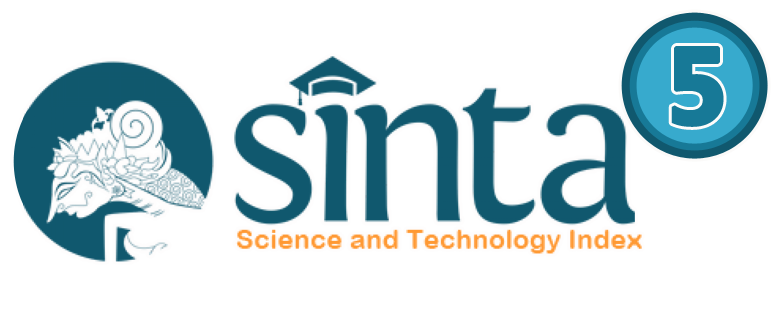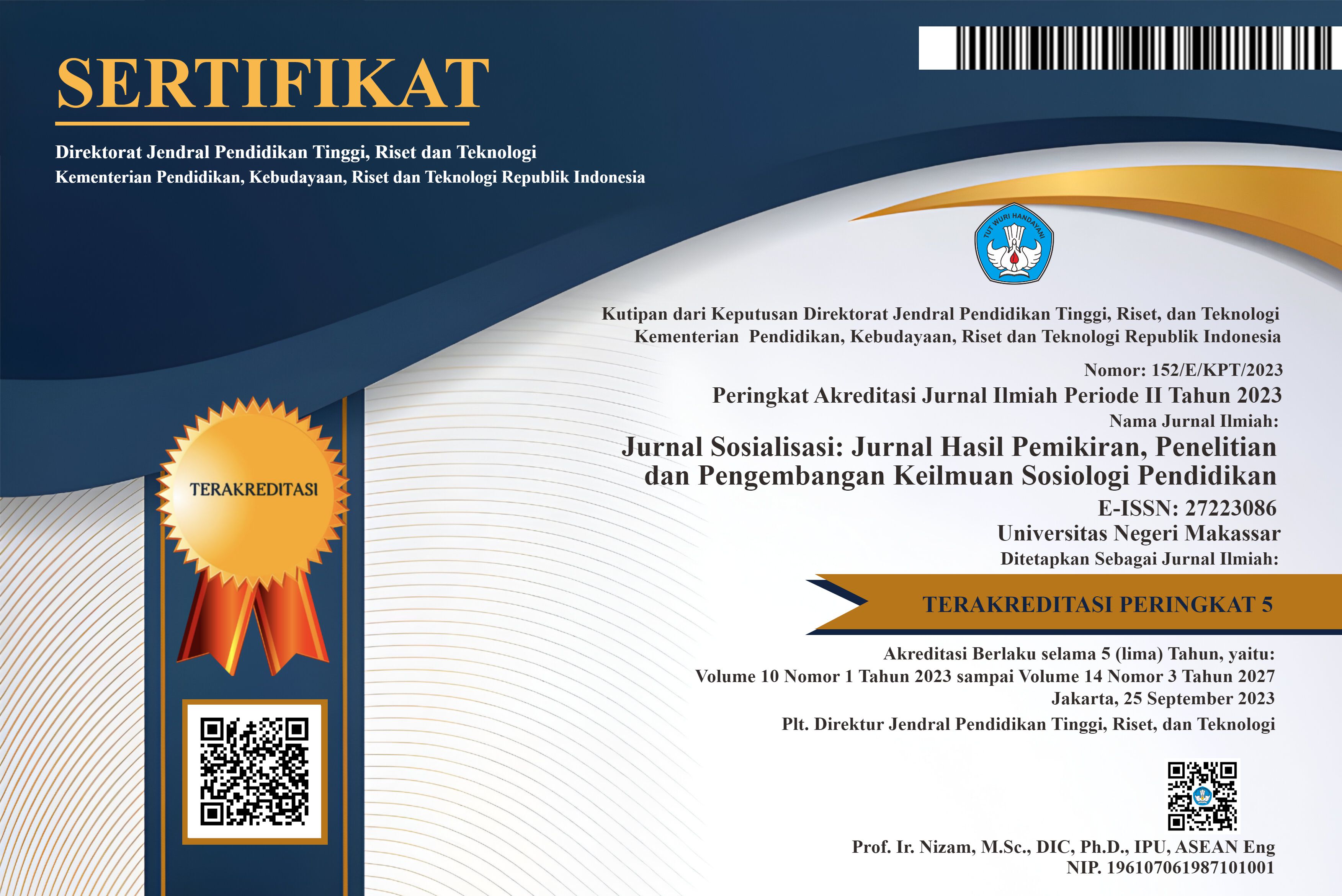Benarkah Sikap Terhadap Penggunaan Bahasa Menentukan Pilihan Bahasa? Kajian Sosiolinguistik Pada Komunitas Multibahasa
(1) Universitas Mulawarman
(*) Corresponding Author
DOI: https://doi.org/10.26858/sosialisasi.v1i1.59489
Abstract
Keywords
Full Text:
PDFReferences
Amin, A. (2020). Attitude towards language in sociolinguistics settings: A brief
overview. REiLA: Journal of Research and Innovation in Language, 2(1), 27-30. https://doi.org/10.31849/reila.v2i1.3758
Berisso Genemo, T. (2022). Multilingualism and Language Choice in Domains. IntechOpen. doi: 10.5772/intechopen.101660.
Boonsuk, Y., Ambele, E. A., & McKinley, J. (2021). Developing awareness of Global Englishes: Moving away from ‘native standards’ for Thai university ELT. System, 99, 102511. https://doi.org/https://doi.org/10.1016/j.system.2021.102511
Chana U., Romaine S. (1984). Evaluative reactions to Panjabi/English code-switching. Journal of Multilingual and Multicultural Development, 5(6), 447–473. https://doi.org/10.1080/01434632.1984.9994174
Chen, X. (2010). Identity Construction and Negotiation Within and Across School Communities: The Case of One English-as-a-New-Language (ENL) Student. Journal of Language, Identity & Education, 9(3), 163–179. https://doi.org/10.1080/15348458.2010.486274
Derin, T., Nursafira, M. S., Yudar, R. S., Gowasa, N. S., & Hamuddin, B. (2020). Persuasive Communication: What Do Existing Literature Tells Us About Persuasive Communication Among Students?.Utamax: Journal of Ultimate Research and Trends in Education,2(1), 12-18. https://doi.org/10.31849/utamax.v2i1.3468
Dewi, U. P., & Setiadi, C. J. (2018). Language attitude and language choice in a bilingual academic learning environment. Lingua Cultura, 12 (4), 369-373. doi.org/10.21512/lc.v12i4.4288
Dragojevic, M. (2017). Language Attitudes. Oxford University Press. https://doi.org/10.1093/acrefore/9780190228613.013.437
Dragojevic M., Fasoli F., Cramer J., Rakić T. (2021). Toward a century of language attitudes research: Looking back and moving forward. Journal of Language and Social Psychology, 40(1), 60–79. https://doi.org/10.1177/0261927X20966714
Endardi, J., &Rahayu, M. (2023, March). The Diversity of Multilingual Communities. In 4th Annual International Conference on Language, Literature and Media (AICOLLIM 2022) (pp.277-287). Atlantis Press. https://doi.org/10.2991/978-2-38476-002-2_27
Fasya, M., & Sari, D. G. (2021, November). Sociocultural Factors that Determine Language Choice in A Multilingual Society. In Fifth International Conference on Language, Literature, Culture, and Education (ICOLLITE 2021) (pp. 412-418). Atlantis Press. https://doi.org/10.2991/assehr.k.211119.064
Fitriati, A., &Wardani, M. M. S. (2020). Language attitudes and language choice among students in Yogyakarta: A case study at UniversitasSanata Dharma. International Journal of Humanity Studies (IJHS), 3(2), 239-250. https://doi.org/10.24071/ijhs.v3i2.2226
Genesee F. (2001). Bilingual first language acquisition: Exploring the limits of the language faculty. Annual Review of Applied Linguistics, 21, 153–168. https://doi.org/10.1017/S0267190501000095
Getie, A. S. (2020). Factors affecting the attitudes of students towards learning English as a foreign language. Cogent Education, 7(1), 1738184. https://doi.org/10.1080/2331186X.2020.1738184
Harzing, A.-W., & Pudelko, M. (2013). Language competencies, policies and practices in multinational corporations: A comprehensive review and comparison of Anglophone, Asian, Continental European and Nordic MNCs. Journal of World Business, 48(1), 87–97. https://doi.org/https://doi.org/10.1016/j.jwb.2012.06.011
Holmes, J. (2013). An introduction to sociolinguistics fourth edition. Oxon: Routledge.
Hughes M., Kiecolt K. J., Keith V. M., Demo D. H. (2015). Racial identity and well-being among African Americans. Social Psychology Quarterly, 78(1), 25–48. https://doi.org/10.1177/0190272514554043
Kircher R. (2022). Intergenerational language transmission in Quebec: Patterns and predictors in the light of provincial language planning. International Journal of Bilingual Education and Bilingualism, 25(2), 418–435. https://doi.org/10.1080/13670050.2019.1691499
Kridalaksana, H. (2008). Kamus linguistik. Jakarta: Gramedia Pustaka Utama.
Kurniasari, M. D., & Mbato, C. L. (2018). Indonesian students' language attitudes towards Indonesian and English through education and working frame. LLT Journal: A Journal on Language and Language Teaching, 70-86. https://doi.org/10.24071/llt.v21iSuppl.1184
Lambert, Wallace. (1967). A social psychology of bilingualism. Journal of social issues, 23, 2, 91-109.
Larasati, A.A., & Simatupang, M. S. (2020). Relationship Between English Language Attitude and Proficiency. In Proceedings of the 4th International Conference on Language, Literature, Culture, and Education (ICOLLITE 2020), 63-68. Advances in Social Science, Education and Humanities Research, Volume 509. http://dx.doi.org/10.2991/assehr.k.201215.010
Marwa, M. (2014). Reasons for Students’ CodeSwitching Between Informal Indonesian and English in ELT Contexts. ELT-Lectura, 1(1). https://doi.org/10.31849/elt-lectura.v1i1.446
Meyerhoff, M. (2006). Introducing sociolinguistics. New York: Routledge.
Modiano, M. (2001). Ideology and the ELT practitioner.International Journal of Applied Linguistics,11(2), 159-173. http://dx.doi.org/10.1111/1473-4192.00012
Peters, M. A. (2016). Language Attitudes and Identity Construction. In M. Fernández-Villanueva & K. Jungbluth (Eds.), Multimodal Use in Multilingual Contexts (pp. 179–199). De Gruyter. https://doi.org/doi:10.1515/9783110458817-011
Rodríguez-Izquierdo, R. M., Falcón, I. G., & Permisán, C. G. (2020). Teacher beliefs and approaches to linguistic diversity. Spanish as a second language in the inclusion of immigrant students. Teaching and Teacher Education, 90, 103035. https://doi.org/https://doi.org/10.1016/j.tate.2020.103035
Sharifian, F. (2009). English as an International Language. Perspectives and Pedagogical Issues.MPG Book Ltd.
Smagulova, J. (2008). Language Policies of Kazakhization and Their Influence on Language Attitudes and Use. International Journal of Bilingual Education and Bilingualism, 11(3–4), 440–475. https://doi.org/10.1080/13670050802148798
Sumarsono. (2013). Sosiolinguistik. Yogyakarta: SABDA & Pustaka Pelajar.
Tajfel H., Turner J. C. (1986). The social identity theory of intergroup behavior. In Worchel S., Austin W. G. (Eds.), Psychology of intergroup relations (pp. 7–24). Chicago: Nelson-Hall.
Ting, S.-H. (2003). Impact of Language Planning on Language Attitudes: A Case Study in Sarawak. Journal of Multilingual and Multicultural Development, 24(3), 195–210. https://doi.org/10.1080/01434630308666498
Titone D., Tiv M. (2023a). Rethinking multilingual experience through a systems framework of bilingualism. Bilingualism: Language and Cognition, 26, 1–16. https://doi.org/
Titone D. A., Tiv M. (2023b). Rethinking multilingual experience through a Systems Framework of Bilingualism: Response to Commentaries. Bilingualism: Language and Cognition, 26(1), 247–251. https://doi.org/10.1017/S1366728922000785
Tlepbergen, D.; Akzhigitova, A.; Zabrodskaja, A. (2023). Bottom-Up Approac to Language Policy and Planning in Kazakhstan. Societies, 13, 43, https://doi.org/10.3390/soc13020043
Tódor, E., & Dégi, Z. (2016). Language Attitudes, Language Learning Experiences and Individual Strategies What Does School Offer and What Does It Lack? [Abstract]. Acta Universitatis Sapientiae, Philologica, 8(2), 123-137.
Wardhaugh, R. (2006). An introduction to sociolinguistics fifth edition. Malden: Backwell Publishing.
Woo, D., & Giles, H. (2017). Language attitudes and intergroup dynamics in multilingual organizations. International Journal of Cross Cultural Management, 17(1), 39–52. https://doi.org/10.1177/1470595817701507 Tlepbergen, D.; Akzhigitova, A.; Zabrodskaja, A. (2023). Bottom-Up Approac to Language Policy and Planning in Kazakhstan. Societies, 13, 43, https://doi.org/10.3390/soc13020043
Zhang, L. E., & Harzing, A.-W. (2016). From dilemmatic struggle to legitimized indifference: Expatriates’ host country language learning and its impact on the expatriate-HCE relationship. Journal of World Business, 51(5), 774–786. https://doi.org/https://doi.org/10.1016/j.jwb.2016.06.001
Article Metrics
Abstract view : 32 times | PDF view : 4 timesRefbacks
- There are currently no refbacks.

This work is licensed under a Creative Commons Attribution 4.0 International License.


































